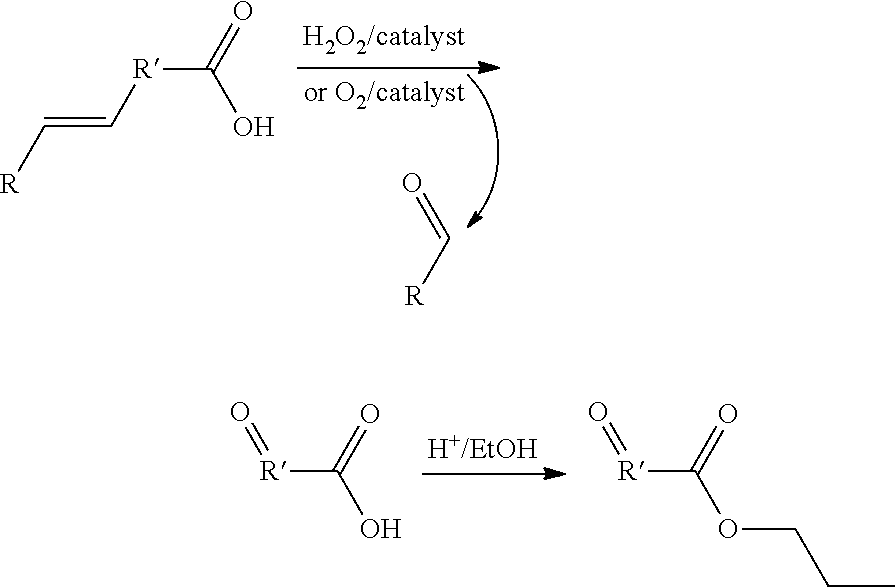Oxidative cleavage of unsaturated carboxylic acids
a carboxylic acid and unsaturated technology, applied in the preparation of carbonyl compounds, carboxylic compound preparations, organic chemistry, etc., can solve the problems of catalyst cost and overoxidation of desired products, and achieve the effect of saving considered materials and costs
- Summary
- Abstract
- Description
- Claims
- Application Information
AI Technical Summary
Benefits of technology
Problems solved by technology
Method used
Image
Examples
example 1
Oxidative Cleavage of Olive Oil
[0040]Using hydrogen peroxide or air and the proper mechanocatalyst olive oil can be converted to a mixture of aldehydes and oxocarboxylic acids; 60% of the available unsaturated carboxylic acids were converted to oxidation products. In this example, 0.5 g of olive oil was mixed with 0.5 g of cerium oxide and 0.5 mL of 30% hydrogen peroxide. The reaction was placed in a 65 mL steel container with three 0.5″ steel balls and agitated in a SPEX mixer mill (8000M) for 30 minutes. The reaction mixture was extracted with dichloromethane to isolate the non-polar fraction. Tables 1 and 2 give the composition of non-polar compounds produced from the oxidative cleavage of olive oil.
TABLE 1Non-polar oxidation products produced from themechanocatalytic cleavage of olive oil. Theitalicized values are calculated properties.MeltingBoilingFlashpointpointpointCompound(° C.)(° C.)(° C.)flavorhexanal−63119-12425green; fattyoctanal−51.7317152honey; fatty; citrus;fruity ap...
example 2
Trans-Cinnaminic Acid
[0042]To further investigate the ability of different reagents in oxidatively cleaving double bonds in an unsaturated carboxylic acid, e.g., trans-cinnamic acid, the reagents set forth in Table 3 below were added to a 65 mL reaction container with three 0.5″ steel balls and agitated in a SPEX Certiprep 8000D ball mill. The mill was run for 30 minutes at a motor speed / rate of 1725 rpm.
TABLE 3Reagent 1Amount (g)Reagent 2Amount (g)Reagent 3AmountProductsTrans-cinnamic0.5014Kaolin0.5016No ProductsacidTrans-cinnamic1.0022No ProductsacidTrans-cinnamic0.5033Kaolin0.5012Water20DropsNo ProductsacidTrans-cinnamic1.0011Water20 DropsBenzaldehydeacidTrans-cinnamic0.5080Kaolin0.50753% H2O220DropsBenzaldehydeacidTrans-cinnamic1.00273% H2O220 DropsBenzaldehydeacidTrans-cinnamic0.4943Palladium0.4913No ProductsacidTrans-cinnamic0.5036PdO0.5068No ProductsacidTrans-cinnamic0.5028CuO0.5028No ProductsacidTrans-cinnamic0.5016MnO20.5021No ProductsacidTrans-cinnamic0.5013MoO30.5014No Pr...
example 3
Oxidative Cleavage with Air
[0043]In this example, air was used as a mild oxidizing agent for the oxidative cleavage of trans cinnamic acid to benzaldehyde and glyoxylic acid. (a) 1 g of cerium oxide and 1 g of trans cinnamic acid were placed in a rolling ball mill with gass flow capabilities. Approximately 100 g of milling media were added in the form of 0.5″ steel balls. The ball mill was run with air flowing through it at a rate of 0.5 cubic foot per minute. The ball mill was run for 12 hours at a speed / rate of 200 rpm to produce benzaldehyde.
[0044]The present invention, in various embodiments, includes components, processes, systems and / or apparatus substantially as depicted and described herein, including various embodiments, subcombinations, and subsets thereof. Those of skill in the art will understand how to make and use the present invention after understanding the present disclosure. The present invention, in various embodiments, includes providing devices and processes in ...
PUM
| Property | Measurement | Unit |
|---|---|---|
| Fraction | aaaaa | aaaaa |
| Fraction | aaaaa | aaaaa |
| Fraction | aaaaa | aaaaa |
Abstract
Description
Claims
Application Information
 Login to View More
Login to View More - R&D
- Intellectual Property
- Life Sciences
- Materials
- Tech Scout
- Unparalleled Data Quality
- Higher Quality Content
- 60% Fewer Hallucinations
Browse by: Latest US Patents, China's latest patents, Technical Efficacy Thesaurus, Application Domain, Technology Topic, Popular Technical Reports.
© 2025 PatSnap. All rights reserved.Legal|Privacy policy|Modern Slavery Act Transparency Statement|Sitemap|About US| Contact US: help@patsnap.com



